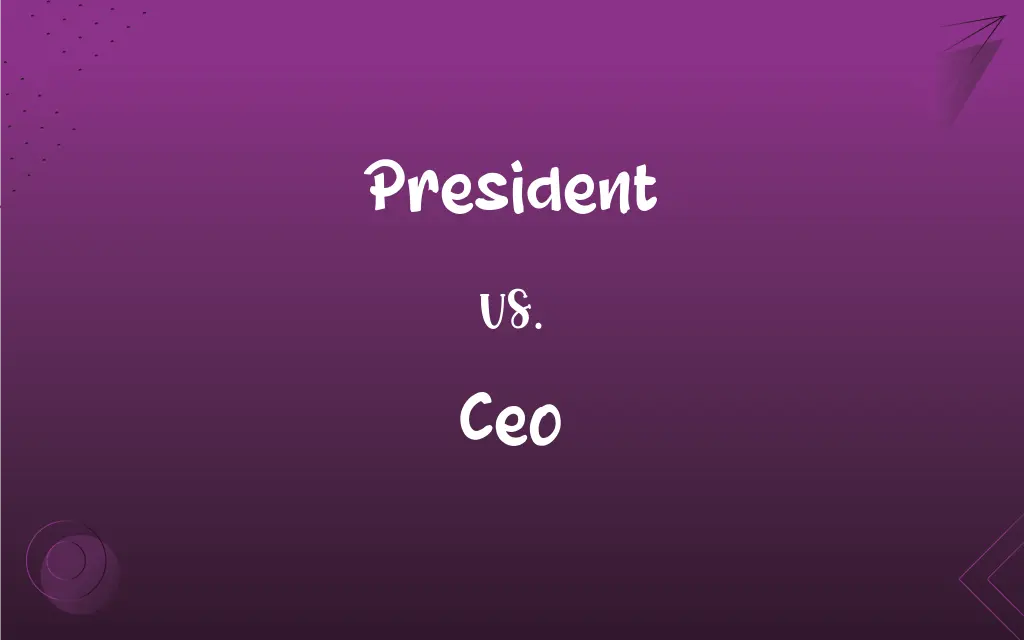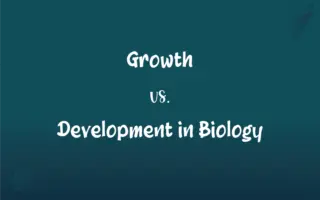President vs. CEO: What's the Difference?
Edited by Janet White || By Harlon Moss || Updated on October 24, 2023
A president is often a high-ranking executive or head of state, while a CEO (Chief Executive Officer) is the highest-ranking executive in an organization responsible for strategic decisions.

Key Differences
The title of president often signifies a high-ranking position within an organization or a head of state in many countries. In a corporate setting, the president might oversee specific divisions or operations. On the other hand, the CEO is typically the highest-ranking executive in a company. They are responsible for making major corporate decisions and managing the overall operations and resources of the organization.
While both president and CEO are leadership titles in a business, their roles can differ based on the company's structure. In some companies, the CEO may also hold the title of president, combining both roles. However, in larger corporations, they are distinct, with the CEO focusing on overarching strategy and vision, while the president might focus on day-to-day operations.
In a political context, the term president commonly refers to the elected head of state or government, like the President of the United States. In this capacity, the president's duties are far removed from those of a CEO. The president serves the citizens and governs the nation, whereas a CEO leads a private or public organization aiming for growth and profitability.
Furthermore, the method of appointment or election differs for the two roles. CEOs are usually appointed by a board of directors of a company. Presidents, when referring to a political role, are often elected by citizens or representatives of a country.
Comparison Chart
Primary Role
High-ranking executive or head of state
Highest-ranking executive in an organization
ADVERTISEMENT
Focus
Might oversee specific divisions or operations
Overall strategy, vision, and decisions
Political Context
Elected head of state or government
Not applicable
Appointment/Election
Elected by citizens or company's hierarchy
Appointed by the board of directors
Overlap
Can sometimes also be a CEO
Can sometimes also be a president
President and CEO Definitions
President
A president is a head of state or government.
The president gave a speech about the country's progress.
ADVERTISEMENT
Ceo
The CEO is responsible for overall strategic decisions.
The CEO decided to enter the new market segment.
President
A president may oversee specific sectors or branches.
The president of sales discussed last quarter's results.
Ceo
A CEO is the highest-ranking officer in an organization.
The CEO unveiled the company's vision for the next decade.
President
A president can be a high-ranking executive in a company.
The president of the division announced a new initiative.
Ceo
CEOs oversee the company's entire management.
Under the new CEO, the company saw significant growth.
President
The president title denotes seniority and responsibility.
The president of the university addressed the graduating class.
Ceo
The CEO's role is pivotal for a company's direction and success.
The CEO's leadership style brought about innovative changes.
President
A president represents authority and leadership.
The president made the final decision on the project.
Ceo
A CEO often interacts with the board of directors.
The board expressed confidence in the CEO's strategy.
President
One appointed or elected to preside over an organized body of people, such as an assembly or meeting.
Ceo
(aviation) CEO
Ceo
The corporate executive responsible for the operations of the firm; reports to a board of directors; may appoint other managers (including a president)
FAQs
What does president mean in a corporate context?
In a corporate context, a president is a high-ranking executive, often below the CEO, overseeing specific operations.
Who typically appoints the CEO?
The board of directors usually appoints the CEO of a company.
What are the primary duties of a CEO?
A CEO oversees the company's strategy, vision, and major decisions, and manages its overall resources.
Is the CEO the same as the president in companies?
Not always. In some companies, the roles are distinct, but in others, one person may hold both titles.
Can a country have both a president and a CEO?
A country has a president as a political leader, while a CEO leads a company. They're roles in different contexts.
Who does a corporate president report to?
In many companies, the president reports to the CEO.
Who typically has more influence in a company, the CEO or president?
Generally, the CEO, being the highest-ranking officer, has more influence over the entire company.
In the case of a company merger, who typically remains, the CEO or president?
It varies based on the terms of the merger, but often the CEO of the larger or acquiring company remains in a leadership role.
Do all companies have both a president and a CEO?
No, the presence and distinction of these roles vary based on the company's structure and size.
Can a CEO be elected, like a president in politics?
CEOs are typically appointed by a company's board of directors, while political presidents are elected.
Can a company function without a CEO or president?
Yes, but there must be a clear leadership structure and delegation of responsibilities.
How does the decision-making power differ between a president and CEO?
While both have decision-making authority, the CEO often has the final say on overarching company strategy and direction.
Do all countries have a president?
No, some countries have monarchs, prime ministers, or other titles for their leaders.
How is a president's salary determined in a company?
It's often based on industry benchmarks, company performance, experience, and negotiated terms.
Can the CEO make decisions without the board's approval?
For major strategic decisions, board approval is often needed, but day-to-day decisions are typically at the CEO's discretion.
Do the roles of CEO and president exist worldwide?
While the titles are common globally, their specific responsibilities and prominence might differ across cultures and regions.
How does a president in a company differ from one in government?
In a company, a president oversees certain operations, while in government, a president is the head of state or government.
How do the responsibilities of a CEO vary across companies?
Responsibilities may differ based on company size, industry, and specific challenges the company faces.
How long does a CEO typically serve in their role?
It varies widely, from a few years to several decades, depending on performance and company dynamics.
Is the CEO role more prevalent in certain industries?
The CEO title is common across industries, but the specific responsibilities might differ based on the industry.
About Author
Written by
Harlon MossHarlon is a seasoned quality moderator and accomplished content writer for Difference Wiki. An alumnus of the prestigious University of California, he earned his degree in Computer Science. Leveraging his academic background, Harlon brings a meticulous and informed perspective to his work, ensuring content accuracy and excellence.
Edited by
Janet WhiteJanet White has been an esteemed writer and blogger for Difference Wiki. Holding a Master's degree in Science and Medical Journalism from the prestigious Boston University, she has consistently demonstrated her expertise and passion for her field. When she's not immersed in her work, Janet relishes her time exercising, delving into a good book, and cherishing moments with friends and family.































































